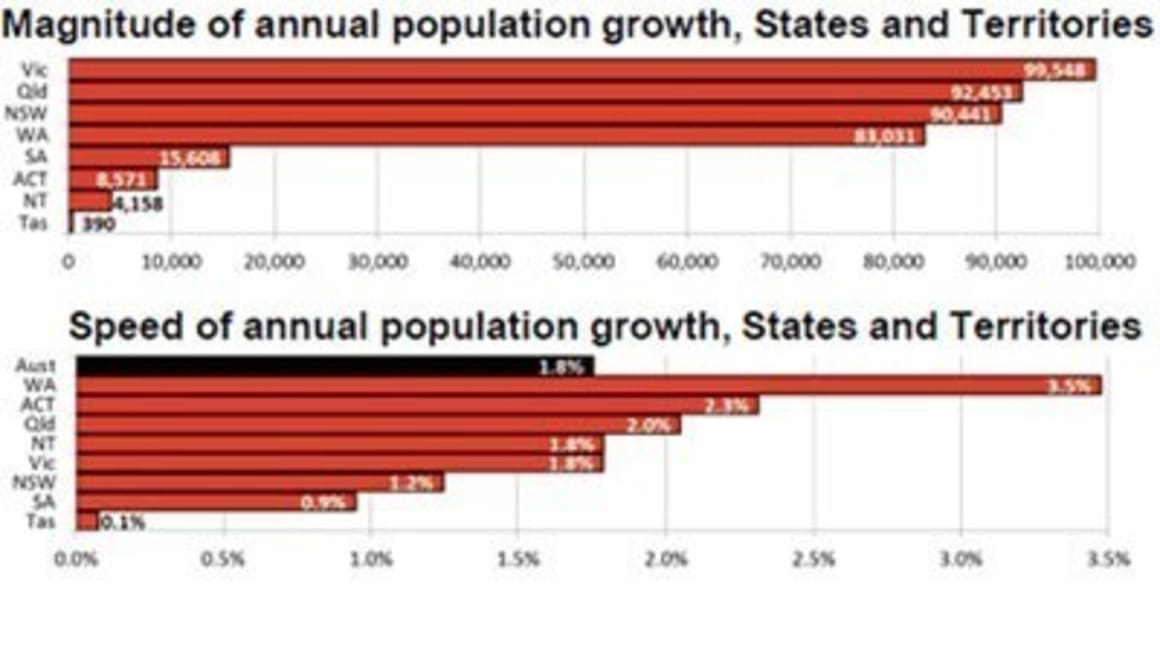WA population growth rate almost double the national average: Tim Lawless

According to the Australian Bureau of Statistics (ABS), Australia’s population grew to record 22.9 million people now living in the country at the end of 2012.
The growth was driven by strong net overseas migration which accounts for 60% of the total population growth.
A record number of births added to the annual tally.
This figure now equates to an increase in Australia’s national annual population growth of 1.75% over the December 2012.
While the Australian Bureau of Statistics (ABS) recorded 22.9 million residents at the end of last year, a more recent estimate of the current population can be seen in the ABS Population Clock which is currently indicating a national population of 23.094 million residents.
Click to enlargeVictoria trumped the pack as the state to record the highest levels of population growth across the country’s states and territories for the 2012 calendar year where an additional 99,548 residents now reside in the state.
Overseas migration accounted for 56.4% of the state’s growth, however, a larger than average proportion of Victoria’s population growth was from natural increase (41.8%), while a very small proportion can be attributed to interstate migration flows (1.7%).
Queensland recorded the second largest number of new residents at 92,453, followed by New South Wales where there were 90,441 more residents over the year.
The contributing components of population growth were quite different between Queensland and New South Wales.
While both states are sourcing the majority of their population growth via overseas migrants, Queensland has historically recorded a substantial net interstate migrant inflow; last year 11,354 net new residents moved to Queensland from other Australian states while New South Wales lost a net 17,761 residents to other states.
Click to enlargeIn raw numbers, Western Australia recorded the fourth largest number of new residents (+83,031) but was the state to record the fastest rate of population growth by quite a wide margin.
At almost twice the pace of the national average, Western Australia’s population increased by 3.5 % over the 2012 calendar year and has attracted the third largest number of net overseas migrants with 52,306 new permanent or long term residents moving to Western Australia over the calendar year.
The Australian Capital Territory (ACT) also recorded a rapid rate of population growth, up 2.3 % over the 2012 calendar year; the second fastest growth rate of any state or territory.
With the impending election and possible cuts to the Federal Government labour force, we would presume this rate of population growth is likely to slow during 2013.
Tasmania and South Australia recorded the least amount of population growth, up by 0.9% and 0.1% respectively.
Interstate migration has been a drain on both states with a net 2,650 Tasmanian’s moving to another state or territory and 3,345 net South Australians moving interstate over the year.
Nationally, Australia’s population growth is comprised of the net rate of overseas migration plus the rate of natural increase that is births minus deaths.
Click to enlargeOverseas migration is the most significant contributor to population growth, equating to 60% of national population growth.
The rate of natural increase has seen a substantial rise due to a large number of new births and a decline in the number of deaths over the year.
There were 305,400 births in Australia over the past twelve months, the largest number on record.
Tim Lawless is national research director of RP Data.


